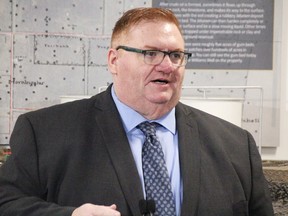It’s fitting to talk about carbon capture in the place where oil was discovered, officials said Wednesday, gathered in Oil Springs to hear from Ontario Natural Resources and Forestry Minister Graydon Smith.

It’s fitting to talk about carbon capture in the place where oil was discovered, officials said Wednesday, gathered in Oil Springs to hear from Ontario Natural Resources and Forestry Minister Graydon Smith.
Advertisement 2
Article content
Starting in 2024, companies will be able to apply provincially to develop pilot plants to test ways to store carbon permanently underground, the minister said at the Oil Museum of Canada, on the site where the first oil in North America was discovered in 1858.
Article content
“There’s no better place to do it than right here, to make this exciting announcement” about enabling carbon capture and storage demonstration plants on private lands, Smith said.
Melissa Candelaria, with the minister’s office, said applications open Jan. 1.
Hopes are, pending pilot plant success, to have “full-scale commercialization” in 2025, Smith said.
“It’s an aggressive timeline and one that we want to work through quickly” while being deliberate to ensure viability and safety, he said.
Advertisement 3
Article content
“Obviously there’s great interest from industry and from the public as well.”
Industries in general that emit carbon are looking for ways to reduce their impact, said Wayne Passmore, Enbridge technical manager of execution and special projects, who was in attendance Wednesday.
The chance to test how carbon capture and storage fits into that equation, “we’re excited for that,” he said.
“We’ve got a lot of customers who have reached out to us to ask for our help to help them decarbonize,” he added. “So we’re looking at renewable natural gas, hydrogen, other efforts that way; and carbon capture and storage is one of those tools that could potentially help here in Ontario for the large emitters that we serve … to help them manage their greenhouse gas emissions.”
Advertisement 4
Article content
Enbridge is looking at a number of possible sites where the geology might be suitable, he said.
The process is, in part, about evaluating whether carbon capture and storage is economically feasible in Ontario, he said.
“That’s the big question.”
The approach has had mixed results elsewhere in the world, Smith said.
“Because of that, we need to ensure that any activity we do here in Ontario is done responsibly, with measures in place to safeguard people and the environment,” he said.
“This is really where the geology works, is in southwest Ontario, for this technology,” he added later.
The government also has made changes to the Oil, Gas and Salt Resources Act to allow carbon capture, and has a roadmap to start using a “made-in-Ontario” approach, Smith said.
An update of one aspect of that road map, “Phase 3 toward commercialization” is expected “early in the new year,” he said.
Ed Brost, an associate with the sustainable-energy think tank Bowman Center in Sarnia has said carbon capture and storage technology is viable, but the cost, historically, has been a problem.
Carbon capture and storage is listed as one of several components in the province’s low-carbon hydrogen strategythat also includes identifying provincial hydrogen hubs and supporting hydrogen research.
Article content